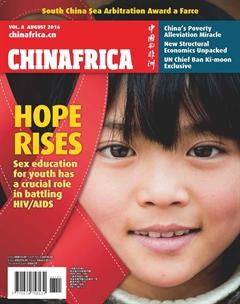The Crown Jewel
By Jeremy Stevens

The launch of the new Development Bank(NDB) by the BRICS countries - Brazil, Russia, India, China and South Africa - in 2015 was timely, at a time when the original validation for the establishment of the grouping - rapid and stable economic growth - had been comprehensively undermined, threatening to turn BRICS into a geopolitical fad.
It seemed the NDB would provide the muchneeded institutional underpinning for the group to create common objectives, and transcend into a force with tangible impact on the global development stage.
However, two years on and the NDB hasnt come close to serving as any kind of spearhead. Clearly then, a great deal of work lies ahead of the NDB in establishing a clear role and presence in the fabric of the global financial architecture.
The last few years sapped life from BRICS, revealing what it really is: a bloc of globally interdependent emerging-market economies. It is undeniable that in the run-up to the financial crisis in 2008, BRICS growth strongly exceeded the economic growth of industrialized countries, resulting in a surge in cross-border portfolio investment flows. The allure of these economies was heightened when the financial crisis first hit the real economy of advanced nations. Many speculated that this new group of large and diversified emerging-market economies would be able to insulate itself from the problems manifesting elsewhere.
Slowest pace
Indeed, in terms of GDP growth, BRICS managed to outperform, sending the optimistic narrative to dizzy heights. Nevertheless, the all-hands-ondeck attitude of policymakers to place a floor under economic activity has come at a cost. We have seen a huge rise in leverage in the emerging markets universe, which has helped shield these economies from the slowdown. However, there is increasing concern in this regard, especially given the slowdown of nominal growth, which reduces the debt capacity. Today, BRICS is in a very different situation than before the collapse of Lehman Brothers.
Now, it has become increasingly difficult to maintain the veneer of growth. The BRICS growth has slowed every year since 2010, stumbling most recently from an average 3.4 percent in 2014 to just 1.7 percent in 2015, the slowest pace of expansion in nearly 30 years (except for 2009).
The concept and emergence of BRICS did shatter the macroeconomic stereotypes prevailing at the time. Until the mid-2000s, the world economy had been divided into developed and developing economies, which had in-built assumptions about risks, returns and various policy scenarios. BRICS altered the status quo materially, adding much-needed nuance. Yet, at the same time, it is simply not possible to ignore the strong business cycle synchronization between the rest of the world and BRICS.
Dealing with fragilities
Now, looking at the economic landscape, it is critical to avoid forgetting the lesson of nuance: each BRICS member is very different, and so are their respective economic challenges. Perhaps the most powerful characteristic each shares is that they need to deal with their own domestic fragilities now.
It is quite clear that China must embark on deleveraging and domestic restructuring. For Brazil, the inability of successive governments to implement successful economic reforms is problematic. India runs chronic trade and fiscal deficits, and the government spends a significant part of its revenue on interest payments, subsidies, salaries, and pensions. Russias economy faces weak growth and low oil prices, exacerbating the weak underlying investment environment. And South Africa has to deal with things such as its huge unemployment rate and glacial economic growth.
The question is: will the economic and political challenges derail the groups broader ambitions to play a more significant role in global affairs? The answer must be a resounding “no.”Collectively, their GDP now nearly equals the United States. More generally, in terms of eco- nomics, demographics and geography, BRICS stands out. Quite simply, it matters because it is felt in any macro variable.
Herein lies the rub: big is not the same as cohesive. This is why the BRICS bank matters so much. In forming the NDB, the group has taken a giant step creating an institutional underpinning around which they can take concrete steps for creating clear and shared objectives that can lead to a collective journey. Thus, the NDB is the crown jewel of BRICS.
The NDB can go a long way in establishing the groups economic and political position in a more multipolar global financial architecture. It will work with the existing institutions of the global financial architecture, like the International Monetary Fund. In fact, the majority of the NDBs leadership has experience in these institutions and the bank has made formal pledges for cooperation on a host of occasions.
Sure, the NDB has already confirmed that its first loan will be denominated in yuan, but the developmental task ahead of BRICS is large and there is more than enough space for like-minded institutions. The banks primary function will be to mobilize resources for infrastructure and sustainable development projects inside BRICS and other emerging economies.
Despite slow progress, the bank is viewed with much enthusiasm among BRICS since it was first suggested at the conclusion of the Fourth BRICS Summit in New Delhi in 2012. The NDB announced in mid-2015 that its first loans would occur in 2016. Optimistic forecasts predict that it could lend as much as $30 billion per year in the next five years.
Irrespective of the accuracy of these predictions, the bank provides the group with a shared tool to meet its own developmental objectives. Getting this right is important, though the path ahead will be challenging. Yet, more importantly, much of the envisioned economic changes we expect in these key economies in coming years will place them on firmer footing.

